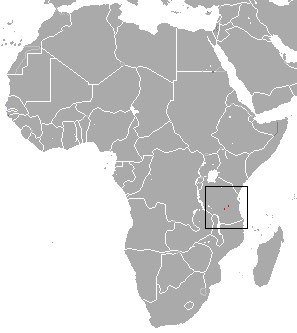Sanje mangabey facts for kids
Quick facts for kids Sanje mangabey |
|
|---|---|
 |
|
| Conservation status | |
| Scientific classification | |
| Genus: |
Cercocebus
|
| Species: |
sanjei
|
 |
|
| Sanje mangabey range | |
The Sanje mangabey (Cercocebus sanjei) is a special type of Old World monkey that lives only in the Eastern Arc Mountains of Tanzania. These monkeys are quite rare and are considered "endangered". This means there aren't many left in the wild.
Sanje mangabeys are usually about 50 to 65 centimeters (20 to 26 inches) long, not counting their tails. Their fur is mostly grey. They love to eat fruit, which makes up about 70% of their diet! They live in forests, often near rivers and on mountain slopes. They spend a lot of time on the ground, which can make them easy targets for hunters. Their homes are also shrinking because of human activities.
Contents
Discovering the Sanje Mangabey
How Was It Found?
In 1979, two people who study nature were exploring a faraway forest in the Udzungwa Mountains in Tanzania. They heard a sound that they knew belonged to a mangabey monkey. But here's the exciting part: no one knew that mangabeys lived in these mountains before!
They looked closer and found a brand-new type of mangabey. This was a big deal because it was the first new species of primate (like monkeys, apes, and humans) found in East Africa in many years. An American scientist named Russell Mittermeier officially described this new monkey in 1986. He gave it the scientific name Cercocebus sanjei.
What Does the Sanje Mangabey Look Like?
Size and Features
The Sanje mangabey is a medium-sized monkey. Both males and females look similar, but males are a little bigger. They are about 50 to 65 centimeters (20 to 26 inches) long, not including their long tails. They usually weigh around 7 to 9 kilograms (15 to 20 pounds).
Their snouts are grey, and the rest of their faces are pinkish or greyish. They have a light bluish line where their fur meets their face. Their eyelids and the area under their eyes are very pale. The hair on top of their heads is longer and sometimes has a swirl or a part. This hair is dark at the bottom and greyish-brown higher up.
The fur on their backs, sides, and legs has creamy grey bases with darker grey shafts. The tips of these hairs have bands of yellowish-orange and black. Their bellies have long, pale yellowish-orange fur. Their hands and feet are dark grey. The skin under their tails is bluish-grey with a hint of pink. They also have pink pads on their bottoms called ischial callosities. Their long, grey tails have a small tuft of longer hairs at the very end.
Where Do Sanje Mangabeys Live?
Their Forest Homes
This mangabey lives only in East Africa, specifically in two forests in the Udzungwa Mountains of south-central Tanzania. They can be found at different heights, from 300 to 1800 meters (about 980 to 5,900 feet) above sea level. However, they are most common in forests that stay green all year round, especially at middle heights.
They also live in areas with a mix of evergreen and trees that lose their leaves. Sometimes, they even visit lower-lying woodlands or farm fields. They often hang out in forest valleys near rivers. They can also be seen on dry, open slopes with a few trees, bracken ferns, and Rubus plants (like raspberries).
Daily Life of a Sanje Mangabey
What Do They Eat?
Sanje mangabeys are active during the day. They spend about half their time on the ground and the other half looking for food in the middle and upper parts of the forest trees. They also search for food in the understory, which is the layer of plants below the main tree canopy.
Groups of mangabeys have a special area they call home. At night, they sleep in one of about eight groups of tall trees that they use regularly. In the morning, before they go out to find food, they often make a loud "whoop-gabble" call from these sleeping trees.
On the ground, they search through fallen leaves for fruits, seeds, and nuts. They also look for ants and other small creatures, roots, and fungi. In the trees, they eat fruits and seeds. They often store fruits like figs or hard seeds from Parinari excelsa in their cheek pouches. Later, they crack them open using their strong premolar teeth.
Why Are Sanje Mangabeys Endangered?
Threats to Their Survival
The Sanje mangabey lives in a very small area and its population is split into two groups that are far apart. Their forest homes are being cut down for wood and to make charcoal. This means they have less and less space to live.
Sadly, these monkeys are also hunted for food and to be sold as pets. Traps are set in the forest, and their meat is sometimes sold in local villages. Because they spend a lot of time on the ground, they are easier to catch.
The number of adult Sanje mangabeys is going down. In 2005, it was thought there were only about 1300 of them left in total. Because of all these dangers, the International Union for Conservation of Nature has listed the Sanje mangabey as "endangered". This means they are at a very high risk of disappearing forever if we don't protect them.


